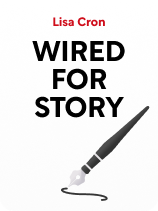

This article is an excerpt from the Shortform book guide to "Wired for Story" by Lisa Cron. Shortform has the world's best summaries and analyses of books you should be reading.
Like this article? Sign up for a free trial here.
Why does suspense keep people engaged in a story? Do you know how to provide useful hints without giving too much away?
In Wired for Story, Lisa Cron shows writers how to create compelling narratives that satisfy our brains’ innate expectations of story. In her discussion of plot elements, she explains how suspense and reveals add excitement to a story and give readers a reason to keep reading.
Read more to learn how to create suspense in a story by understanding why suspense draws people in.
Suspense in a Story
According to Cron, the push and pull between two conflicting forces allows the writer to build suspense by withholding information that the reader wants to know. Suspense is what keeps the reader turning the page because of our cognitive need to know what happens next. Let’s take a look at her practical advice on how to create suspense in a story.
While the big “reveal” of withheld information can be extremely powerful, it works only if everything up until that reveal is clear and logical enough for the reader to understand. The writer must give hints about the reveal in advance so the reader has a sense that something is missing. But, the absence of that missing piece can’t obscure the story.
These hints must also be specific enough that the reader can guess what the reveal might be, even if their guesses prove to be completely wrong. It’s not interesting enough to know that the writer is keeping something secret. We have to have some sense of what they’re keeping secret.
For instance, a mystery writer might plant hints throughout the plot that point to the identity of the murderer. The reader will know the writer is keeping the murderer’s identity a secret to be revealed later. Even if they incorrectly guess who it is, they’ll still be able to understand the logical sequence of events that led the person to kill because the writer’s withholding of the murderer’s identity won’t obscure the rest of the story.
A reveal can’t be the piece that gives the plot meaning, but it can—and should—change the meaning in retrospect as readers look back through the story and understand what new light the reveal sheds on what’s happened.
(Shortform note: Writers may be particularly reluctant to share important information for fear of spoiling their reveals, but research shows that spoilers don’t actually interfere with our enjoyment of a story. In fact, they can even make us enjoy the tale more because we can focus on the aesthetic pleasure of the story without being distracted by the plot. This contradicts Cron’s suggestion that withheld information is what keeps the audience reading, as does the notion that we can reread stories we already know without enjoying them any less. Based on this research, suspense may be less vital in holding the reader’s attention than Cron suggests.)
Foreshadowing
This leads to another important idea from neuroscience: Part of the way we make sense of what’s happening to us is to call on memories from the past that help us interpret what’s going on in the present. According to Cron, you need to provide your reader with such memories so major reveals in the story will make sense.
To do this, you can use foreshadowing, which is when you give the reader hints about a change that’s going to happen later in the story. When you foreshadow, you essentially create a memory for the reader to recall later, and that memory helps them make sense of eventual character or plot changes. Foreshadowing importantly also lets you justify a choice by your protagonist that seems out of character. In fact, any out-of-character choice your protagonist makes must be warned of in advance.

———End of Preview———
Like what you just read? Read the rest of the world's best book summary and analysis of Lisa Cron's "Wired for Story" at Shortform.
Here's what you'll find in our full Wired for Story summary:
- How humans have a neurological need for stories
- The formula that the human brain expects to encounter in a story
- How to build a protagonist that engages your reader






